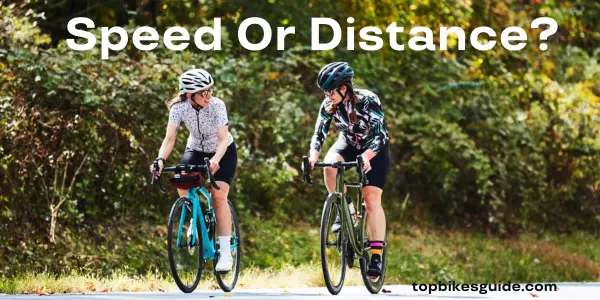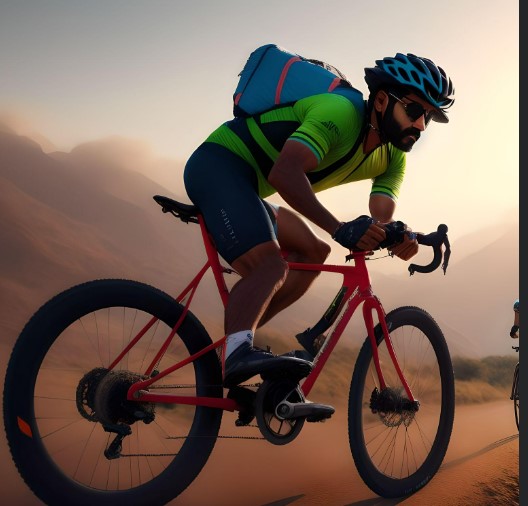As a beginner cyclist, you may be wondering how far you should ride on your bike. Cycling is an excellent form of exercise that provides many health benefits, and the distance you ride can be tailored to your needs. Whether you’re just starting or have been cycling for years, there are many ways to enjoy the sport and reap the rewards of cycling. With the right approach, you can find the perfect balance of distance and intensity to maximize your cycling experience.
How far should a beginner cyclist ride?
For beginner cyclists, the distance of your rides depends on your fitness level and goals. Start with shorter rides of 10 miles or less, gradually increasing as you build strength and stamina. Adjust intensity based on your desired ride experience. Remember to take breaks and stay hydrated. Cycling is a great way to stay active and enjoy the outdoors!
Factors to Consider Before Determining Cycling Distance
Regarding cycling, setting realistic goals and expectations for yourself is important. Before you decide how far you should ride, there are a few factors to consider.
1. Physical fitness level: The distance you can ride depends on your fitness level. If you are just starting, start with shorter distances and gradually build up your endurance and strength.
2. Cycling experience and skills: If you are a more experienced cyclist, you may be able to handle longer distances. But if you are new to cycling, you should focus on developing your skills and learning the basics before attempting longer rides.
3. Cycle Gear: Make sure you have the right gear for the type of cycling you plan. If you plan to ride longer distances, you may need to invest in higher-quality gear designed for longer rides.
4. Route Type: The type of route you plan to ride can also determine the distance you can ride. If you plan to ride on trails or roads, you may need to adjust your distance accordingly.
5. Time availability and commitment: Consider how much time you have for cycling. You may need to adjust your ride distance accordingly if you can only commit to a few hours per week.
Considering these five factors, you can determine how far you should ride as a beginner cyclist. Remember that cycling is a great way to stay active and have fun. So, don’t be afraid to set some goals and challenge yourself.
What Should a Beginner Cyclist Focus On Speed or Distance?
The choice between focusing on speed or distance can be challenging for cyclists. It ultimately depends on your goals and preferences. If you aim to compete in races, prioritize speed. Focusing on distance may be more fulfilling if you’re looking for exploration and exercise. Start with shorter distances and gradually increase as you gain experience. Consider factors like route type and available time. With dedication, you’ll soon be cycling farther than ever before!

10 Cycling Tips For Beginners
To help beginners get started on the right foot, here are ten cycling tips for a successful and safe ride
1. Invest in a quality bike and safety gear: Comfort, safety, and performance are all important factors when buying a bike. Make sure to get something that fits your body properly and suits your planned riding type. Also, always invest in safety equipment like a helmet, appropriate clothing, lights and reflectors, and a belted bike bag.
2. Learn basic bike maintenance: Knowing how to do basic bike maintenance can help you avoid costly repairs in the long run. Simple things like checking your tire pressure, lubing up the chain and brake cables, and tightening bolts are all important to maintaining your bike’s performance and safety.
3. Know your routes: Knowing the roads and trails you will be riding on is important. Look out for potential hazards such as potholes, cars, pedestrians, or cyclists.
4. Set realistic goals: Don’t pressure yourself into achieving unrealistic goals right away. Instead, start small and gradually increase your rides over time.
5. Get a proper warmup: Before starting any ride, warm your body up and stretch out to reduce the risk of injury.
6. Ride with others: Riding with friends or in a group is not only fun, but it can also help you stay motivated, push yourself further, and learn from other riders’ experiences.
7. Take breaks: Don’t push yourself too hard; take regular breaks throughout your ride to rehydrate and have a snack.
8. Stay visible: Always make sure you are visible when riding, especially at night or in poor weather conditions. Wear bright clothing, use lights, and attach reflectors to your bike for visibility.
9. Track your progress: Tracking your mileage is a great way to keep motivated and stay on top of your goals. Several apps and tracking devices are available to help you measure and track the miles you’ve ridden.
10. Have fun: Cycling should be an enjoyable experience, so take time to enjoy it!
Conclusion
In conclusion, beginner cyclists need to understand their physical capabilities and limitations in cycling. It is important to start small and build up stamina and distance gradually. Beginner cyclists should be encouraged if they cannot cycle as far as more experienced cyclists. Everyone has to start somewhere, and with patience and practice, cycling distances will increase over time. Cycling is a great exercise and should be enjoyed at any level and distance.
FAQs
How many miles should I cycle as a beginner?
It depends on your physical capabilities and limitations. Beginner cyclists should start small and gradually increase their cycling distance over time. Being patient and practicing regularly is important to build up your stamina and confidence as a cyclist.
How many km should a beginner cyclist ride?
Similar to miles, it depends on your physical capabilities and limitations. Beginner cyclists should start small and gradually increase their cycling distance over time. Being patient and practicing regularly is important to build up your stamina and confidence as a cyclist.
Can a beginner cycle 20 km?
Yes, a beginner cyclist can cycle 20 km. However, it is important to consider your physical capabilities and limitations. Starting small and gradually increasing your cycling distance over time would be best. Be patient and practice regularly to build your stamina and confidence as a cyclist.
How many miles a week should a beginner cyclist ride?
It depends on your physical capabilities and limitations. Beginner cyclists should start small and gradually increase their cycling distance over time. Being patient and practicing regularly is important to build up your stamina and confidence as a cyclist. A general guideline for beginner cyclists would be to aim for at least 10 miles per week, which can vary depending on the individual.
Can a beginner cycle 100km?
Yes, it is possible for a beginner cyclist to cycle 100km. However, it is important to consider your physical capabilities and limitations. Starting small and gradually increasing your cycling distance over time would be best. Be patient and practice regularly to build your stamina and confidence as a cyclist.
How many km cycling per day?
Again, it depends on your physical capabilities and limitations. Beginner cyclists should start small and gradually increase their cycling distance over time. A general guideline for beginner cyclists would be to aim for at least 20 km per day, which can vary depending on the individual. It is important to listen to your body and stop if you feel any discomfort or pain during exercise.
Can I cycle 100 km without training?
Attempting to cycle 100km with prior training or conditioning is recommended. It is important to gradually increase your cycling distance over time to build up your stamina and confidence as a cyclist. A general guideline for beginner cyclists would be to start with shorter distances, such as 10 km per day, and increase the amount of cycling each week until you reach 100km.
Is 10 km of cycling hard?
10 km cycling is relatively easy for all beginner cyclists. However, listening to your body and stopping if you feel any discomfort or pain during exercise is important. Additionally, building up the stamina necessary for riding longer distances, such as 10 km, may take some time. To do this, it is recommended that you start small and gradually increase your cycling distance over time.
Can I cycle 100 km every day?
It is recommended to attempt to cycle less than 100 km every day. Cycling such a long distance every day can be taxing on your body and may lead to injury or burnout. Instead, it is important to gradually increase your cycling distance over time to build up your stamina and confidence as a cyclist. A general guideline for beginner cyclists would be to start with shorter distances, such as 10 km per day, and increase the amount of cycling each week until you reach 100km.
How can a beginner get better at cycling?
A beginner can improve at cycling by gradually increasing their cycling distance, listening to their body, and focusing on proper form. It is important to start with shorter distances, such as 10 km per day, and increase the amount of cycling each week until you reach 100km.
Is 10 km cycling enough?
This depends on your overall fitness goals. 10 km per day can be enough for some people, depending on their experience level and how much time they must dedicate to cycling daily. However, if you are looking to increase your stamina and endurance as a cyclist, it may be beneficial to gradually increase your cycling distance over time until you reach 100km.
Is biking 15 km a day good?
Yes, biking 15 km daily can be a good way for beginner cyclists to gradually increase their cycling distance as they build their stamina and endurance. However, it is important to listen to your body and adjust the amount of cycling you do depending on your feelings. If you feel tired or sore after biking 15 km a day, it may be best to take a break and rest for a few days before attempting longer distances.
Are 3 miles in 10 minutes on a bike good?
This depends on the type of bike and terrain you are riding. 3 miles in 10 minutes is a relatively fast pace for an average road bike, so it can be considered a good performance if you can complete this distance in this amount of time. However, it may take longer to finish the same distance if you’re riding on hills or off-road trails, so it is important to keep this in mind when assessing your performance.
How hard is it to cycle 20km?
Cycling 20 km is generally considered a moderate distance, and it can take the average person anywhere from 45 minutes to an hour and a half to complete this distance. Depending on their experience level, fitness level, and the terrain they are cycling on, it may be more or less challenging for different people.
Can you lose belly fat by cycling?
Yes, cycling can be a great way to lose belly fat. Cycling is an aerobic exercise that raises your heart rate and helps burn calories which can contribute to weight loss and reduce excess body fat. Additionally, cycling engages your core muscles and strengthens them, helping you lose belly fat faster.
Is 3 miles hard to bike?
This depends on the terrain and difficulty level of the ride. Riding 3 miles on flat roads may be easy for an average cyclist, but biking a hilly route can become more challenging. Your experience and fitness level will also affect how hard it is for you to cycle this distance.

A passionate cyclist with an unwavering love for the open road and founder of topbikesguide.com . Energetic and dedicated, this enthusiast embraces the thrill of speed and the freedom of two wheels.

